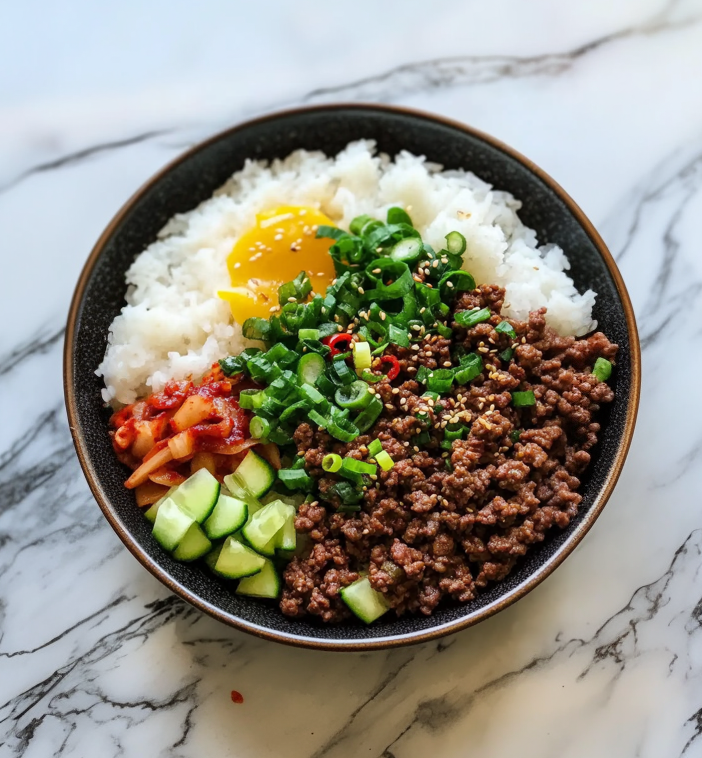This Easy Korean Ground Beef Bowl is a quick and flavorful dish that brings the taste of Korean cuisine to your table in just 20 minutes. It’s perfect for busy weeknights when you want something delicious without spending hours in the kitchen. The combination of savory, sweet, and spicy flavors makes this bowl a family favorite.
Full Recipe
Ingredients
- 1 lb (450g) lean ground beef
- 1/4 cup low-sodium soy sauce
- 2 tablespoons brown sugar
- 1 tablespoon sesame oil
- 3 cloves garlic, minced
- 1 teaspoon freshly grated ginger
- 1/4 teaspoon red pepper flakes (adjust to taste)
- 2 green onions, sliced
- Cooked rice, for serving
- Sesame seeds, for garnish
Directions
- In a large skillet over medium heat, cook the ground beef until browned, breaking it apart as it cooks.
- Drain any excess fat from the skillet.
- Add the minced garlic and grated ginger to the beef, cooking for about 1 minute until fragrant.
- Stir in the soy sauce, brown sugar, sesame oil, and red pepper flakes.
- Let the mixture simmer for 2-3 minutes, allowing the flavors to meld together.
- Serve the beef over cooked rice, garnished with sliced green onions and sesame seeds.
Nutritional Facts
Per serving (approximately 1/4 of the recipe):
- Calories: 420 kcal
- Protein: 26g
- Carbohydrates: 16g
- Fat: 10g
- Saturated Fat: 3g
- Cholesterol: 84mg
- Sodium: 524mg
- Fiber: 1g
- Sugar: 14g
- Vitamin A: 54 IU
- Vitamin C: 1mg
- Calcium: 22mg
- Iron: 4mg
Cultural Significance and Flavor Profile
Korean cuisine is renowned for its vibrant flavors and diverse ingredients. Traditional Korean meals often balance salty, sweet, spicy, and umami tastes, creating a harmonious and exciting eating experience. Korean Ground Beef Bowls borrow heavily from this culinary tradition, blending soy sauce’s salty depth with the caramel sweetness of brown sugar and the subtle warmth of red pepper flakes.
The sesame oil used in the dish adds a nutty aroma and richness, while fresh garlic and ginger contribute layers of pungency and freshness, key elements in many Korean dishes. The green onions and sesame seeds used as garnishes not only enhance visual appeal but also introduce crunch and a burst of freshness to each bite.
Why Korean Ground Beef Bowls are Perfect for Weeknight Meals
One of the primary reasons this recipe has gained popularity is due to its convenience. In today’s fast-paced world, many people struggle to find time to prepare homemade meals that are both nutritious and flavorful. Korean Ground Beef Bowls require minimal preparation time and cook quickly, often ready in under 20 minutes.
The dish is also incredibly forgiving and flexible. It doesn’t rely on precise cooking methods, making it ideal for novice cooks. You can easily double or halve the recipe depending on your needs. Plus, it uses pantry staples that most people already have on hand, which reduces the hassle of shopping for specialty ingredients.
Nutritional Benefits
Korean Ground Beef Bowls provide a balanced meal with a good mix of macronutrients. The ground beef supplies a significant amount of protein, which is essential for muscle repair and growth. Protein also helps keep you full longer, making this dish satisfying and preventing overeating.
The carbohydrates come primarily from the rice served underneath, which provides energy to fuel your day. While white rice is most commonly used, you can opt for brown rice or cauliflower rice to increase fiber content and make the meal more nutrient-dense.
The addition of garlic and ginger brings antioxidant and anti-inflammatory properties, which support immune health. Sesame oil, while used in small amounts, contains healthy fats beneficial for heart health. However, it’s important to balance the amount of soy sauce to keep sodium levels in check.
Customizing Your Korean Ground Beef Bowls
One of the best things about this dish is its versatility. You can adapt the recipe to fit various dietary preferences or nutritional needs. For instance, if you want a lower-carb option, substitute the rice with cauliflower rice or a bed of sautéed vegetables like zucchini noodles or shredded cabbage.
For those who prefer more heat, increasing the amount of red pepper flakes or adding a drizzle of gochujang (Korean chili paste) can elevate the spice level. Conversely, if you want a milder dish, simply reduce or omit the red pepper flakes.
Vegetarians and vegans can swap the ground beef with plant-based crumbles or finely chopped mushrooms for a similar texture and umami flavor. Adding steamed or roasted vegetables such as broccoli, carrots, or bell peppers can increase the dish’s nutrient content and add color and texture.
Serving Suggestions and Pairings
Korean Ground Beef Bowls can be served as a stand-alone meal or complemented with side dishes to create a fuller Korean-inspired spread. Popular Korean sides include kimchi, pickled radishes, or a simple cucumber salad with vinegar and sesame seeds. These sides add crunch and acidity, which contrast nicely with the richness of the beef.
You can also serve this dish with a fried egg on top for extra protein and richness. The runny yolk adds a creamy texture that blends beautifully with the seasoned beef and rice.
For drinks, a light and refreshing beverage such as iced green tea or a citrus-infused water pairs well with the dish’s bold flavors. If you want to embrace more Korean culinary traditions, consider pairing with makgeolli, a traditional Korean rice wine, or soju.
Health Considerations
While Korean Ground Beef Bowls are generally nutritious, there are some health considerations to keep in mind. The soy sauce used in the recipe contains sodium, which can be a concern for individuals managing blood pressure or sodium intake. Choosing a low-sodium soy sauce or tamari can help reduce this.
Additionally, the dish contains a moderate amount of fat from the ground beef and sesame oil. Opting for leaner ground beef (like 90% lean) can lower saturated fat content while still providing flavor and satisfaction.
For those watching their sugar intake, the brown sugar can be reduced or substituted with natural sweeteners like honey or maple syrup, keeping in mind these alternatives will slightly alter the flavor profile.
The Popularity of Korean Cuisine Globally
Over the past decade, Korean cuisine has surged in global popularity, thanks to the widespread love for dishes like bibimbap, bulgogi, and Korean BBQ. This trend is fueled by the growing curiosity for diverse, bold flavors and the health-conscious nature of many Korean dishes, which often include fermented foods, fresh vegetables, and lean proteins.
Korean Ground Beef Bowls represent a fusion of traditional flavors with Western convenience cooking, making them an excellent example of how global culinary influences can come together in an accessible way.
Tips for Making the Best Korean Ground Beef Bowls
To maximize flavor and texture, start with fresh garlic and ginger rather than powders. These fresh ingredients bring brightness and a more complex aroma. Browning the beef well before adding the sauce helps develop depth and richness.
Be mindful not to overcook the beef once the sauce is added, as this can make the meat dry. A quick simmer to meld flavors is enough.
When serving, fluff the rice with a fork to keep it light and airy, ensuring every bite combines well with the saucy beef.
Lastly, don’t be shy with garnishes. Green onions and sesame seeds aren’t just decorative—they add essential freshness and texture that complete the dish.
Conclusion
Korean Ground Beef Bowls are a delicious, convenient, and nutritious meal that suits a wide range of tastes and lifestyles. Their balance of sweet, savory, and spicy flavors makes them an exciting option for those who want to explore Korean cuisine without a steep learning curve.






